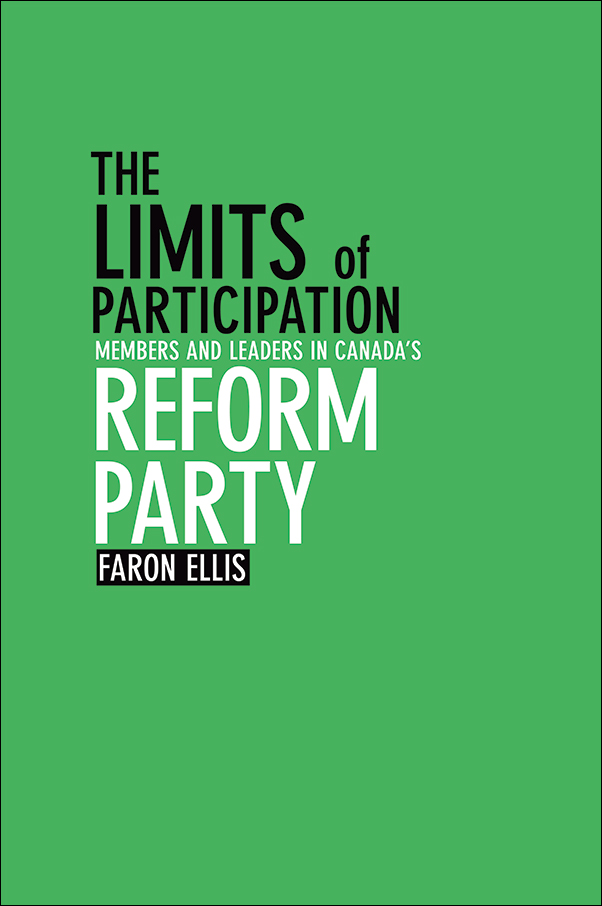
The Limits of Participation: Members and Leaders in Canada's Reform Party
Faron Ellis
$39.95 CAD / $40.95 USD (S)
248 pages, 39 illustrations
6 x 9 inches
Paperback: 978-1-55238-156-4
Library PDF: 978-1-55238-388-9
August 2005
A rich account of the Canadian Reform Party, its development and struggles to build an organization capable of bridging policy demands and strategic plans, and a fascinating inside look at internal party democracy.
The Limits of Participation provides an historical account of the Canadian Reform Party, which shattered the established pattern of Canadian party politics in the late twentieth century.
Faron Ellis provides an analysis of the party’s development as it struggled to build an organization capable of bridging the policy demands of its members with the strategic plans of its leaders. The book examines the party from the perspective of its members by focusing on the opinion structure of activists who helped found Reform, build it into Canada’s official opposition, and eventually decommission it in pursuit of power.
Faron Ellis teaches political science and history at Lethbridge College, where he also acts as director of the Citizen Society Research Lab. A specialist in Canadian government, he has written extensively on the subjects of political history, political parties, and the election process.
List of Tables
Preface
Acknowledgments
Prologue
Introduction
Party Politics in Canada
Four Canadian Party Systems
The First System: Patronage Politics and Caucus Parties (1867–1917)
The First Transition: Emergence of the Farmers’ Parties (1917–1921)
The Second System: Brokerage Politics and Ministerialist Parties (1921–1957)
The Diefenbaker Transition (1957–1962)
The Third System: Leaders and Short–term Agenda Brokering (1963–1988)
The Political Climate in Western Canada in the Late 1980s
Conclusion
The Founding 1987–1989
The First Gathering—May 1987
The Founding Assembly—October 1987
The Party Constitution
The 1988 Federal Election
The First Electoral Victories
Conclusion
The Maturing Membership—The 1989 Assembly
Profiles of Canadian Political Parties at Convention
The 1989 Reform Party Assembly
Revising the Party Constitution
Establishing Policy Precedents
Conclusion
Expanding Beyond the West—1990 to 1992
Expansion: Setting the Stage
The 1991 Reform Party Assembly
Expansion and the Party Constitution
Eastern Expansion and National Office Reorganization
Candidate Recruitment
The Referendum Test of the Organizations
Conclusion
Opinion Structure of Delegates Attending Reform’s 1992 Assembly
Demographics
Year of Initial Involvement in Reform
Previous Political Activity
Internal Activity, Participation and Efficacy
Anti–Political–Establishment Populism
Ideology
Factor Analysis of Issue Items
Attitudes Towards Issue Items
Opinion Structure on Issue Indexes
Opinion Structure on Issue Indexes by Previous Party Activity
Opinion Structure on Issue Indexes by Year of Recruitment
Opinion Structure on Issue Indexes by Province
Final Factor Analysis of Indexes and Indicators
The Road to Official Opposition
Preparing the Ground—The 1992 Assembly
Pre–campaign Posturing
The 1993 Election Campaign
Into the 35th Parliament
The 1997 Election Campaign
Conclusion
The Decommissioning
The United Alternative
The 1999 Reform Party Referendum
The Last Battle
The Alliance Leadership Campaign
Conclusion
Appendix A: Reform Party Membership by Province, 1987–2000
Appendix B: Index Items and Direction
Bibliography
Notes
Index
Ellis provides a useful corrective to previous views of Reform’s membership as merely passive adherents of their leader’s pronouncements.
—Trevor Harrison, The Canadian Historical Review
The book provides an empirically rich account of key elements of the party’s history and a useful reality check on ‘the limits of participation’ – the gap between the rhetoric of populist parties and the realpolitik of Canadian politics.
—Graham White, University of Toronto Quarterly
The Reform Party may be no more, but this book still has much to tell us… as a good case study of the ‘limits of participation’, it should be read by all those interested in the place and possibilities of internal party democracy. As a study of the domestication of an anti-establishment party (its successor won the January 2006 national general election), it should be read by all those interested in the forces changing the shape of the contemporary party systems.
— R. Kenneth Carty, Party Politics